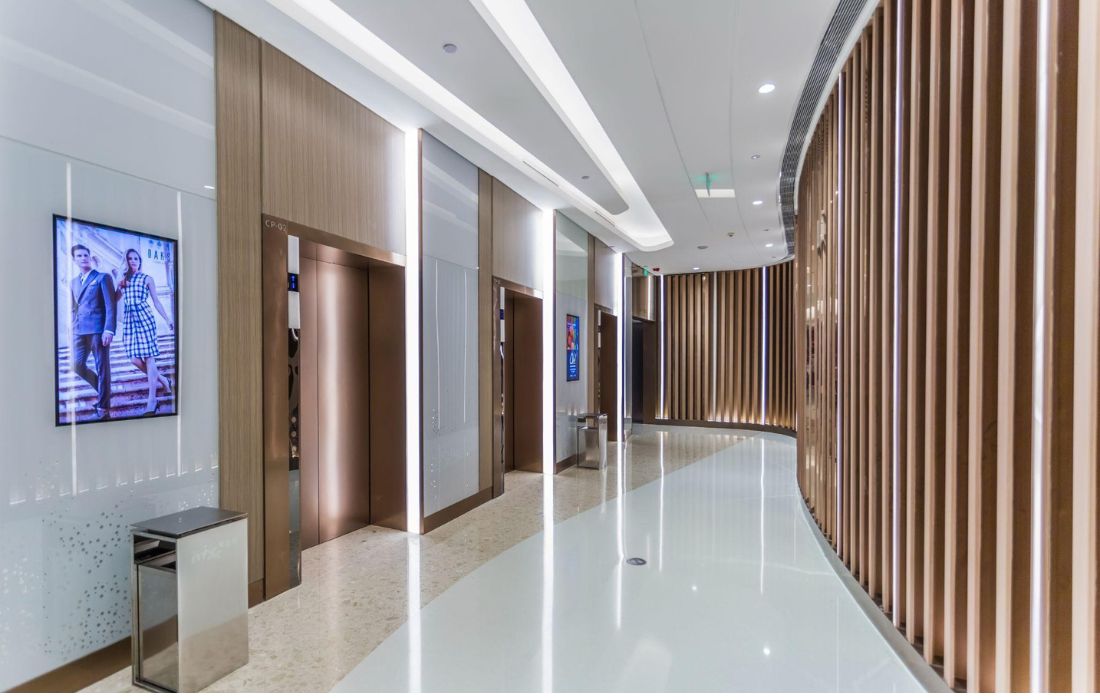Elevators have evolved far from their humble origins as boxes that help people move up and down vertically. They are increasingly becoming the focus of today’s commercial space, a perfect combination of innovation, design, and user experience.
From transparent glass enclosures to touchless controls and energy-conserving systems, modern elevator design is revolutionizing the experience of vertical transport in commercial spaces.
In this article, we share some innovative elevator design ideas for use in commercial buildings.
Table of Contents
Modern Elevator Designs for Commercial Spaces
Elevators, once strictly functional, are now a hub of innovation. Implementing these state-of-the-art elevator solutions can significantly enhance functionality, beauty, and customer satisfaction of commercial buildings.
1. Transparent and Panoramic Elevators
Panoramic and transparent elevators, with complete or partial glass enclosures, offer an immersive experience and sophistication to high-traffic areas like hotel lobbies, corporate office buildings, and shopping malls.
- They also highlight a building’s vertical connectivity and architectural elements.
- They add perceived value and prestige to the entire property.
2. Green and Sustainable Elevators
Green elevators are designed to conserve energy, reduce the environmental footprint, and align with eco-certification needs, yet maintain performance and aesthetics.
- Installation of eco-friendly elevators reduces the carbon footprint of a building and helps it achieve its status as a socially responsible asset.
- Green elevators capture energy consumed on descent and return it to the building’s electrical system.
- Lights dim and elevators go into standby when vacant, thus conserving energy.
- The elevators are constructed using eco-friendly materials for the interiors.
3. Health and Safety Focused Elevators
Post pandemic, health and safety have become top priorities in elevator design. Busy locations like office spaces, hospitals, and shopping malls demand solutions that keep the risk of germ transmission low and provide a sense of security.
- Advanced elevator technologies include features that promote hygiene, minimize physical contact, and enhance passenger comfort.
- Health features include motion sensors, mobile applications, voice systems, or QR code scanning to eliminate surface contact.
- These elevators have automated disinfecting systems, air cleaners, and antimicrobial surfaces.
4. Smart Elevators
Smart elevators increase building efficiency and user satisfaction while offering a futuristic, intuitive user experience that aligns with the demands of modern urban life.
- Smart elevators reduce waiting time, improve traffic flow, and effortlessly fit into the building’s digital landscape.
- Using Destination Control Systems (DCS), passengers select the floor before they get into the elevator, which groups passengers efficiently and reduces stops.
- Smart elevators have real-time monitoring of performance, usage, and maintenance needs.
- The cloud-based control panels allow remote diagnostics, software updates, and smart scheduling.
- Elevators recognize users (through an app, ID card, or facial recognition) and automatically select their preferred floor.
5. Modular and Custom Elevator Design
Modular and customized elevator cabs allow businesses to tailor every component of the cab to represent their identity or user needs.
- A flexible elevator design with interchangeable wall finishes allows for quick upgrades, tenant-specific branding, and long-term cost savings.
- Dynamic LED lighting can change based on time of day, mood, or special events.
- Elevators have materials and patterns to match lobby design or create a striking contrast, screens that showcase logos, welcome messages, or promotional content.
More Than a Ride: Elevator Designs That Inspire
As commercial spaces continue to evolve, elevators are entering a new role—not just as vertical transportation devices, but as an experience that integrates innovation and efficiency of the building.
From smart technology and green systems to panoramic glass cabins and modulated interiors, modern-day elevator design is changing how individuals interact with built spaces.
The right elevator design does not just move people; it elevates your entire building forward.
Also Read: Smart Square HMH Review: A Practical Take on Healthcare Workforce Scheduling







